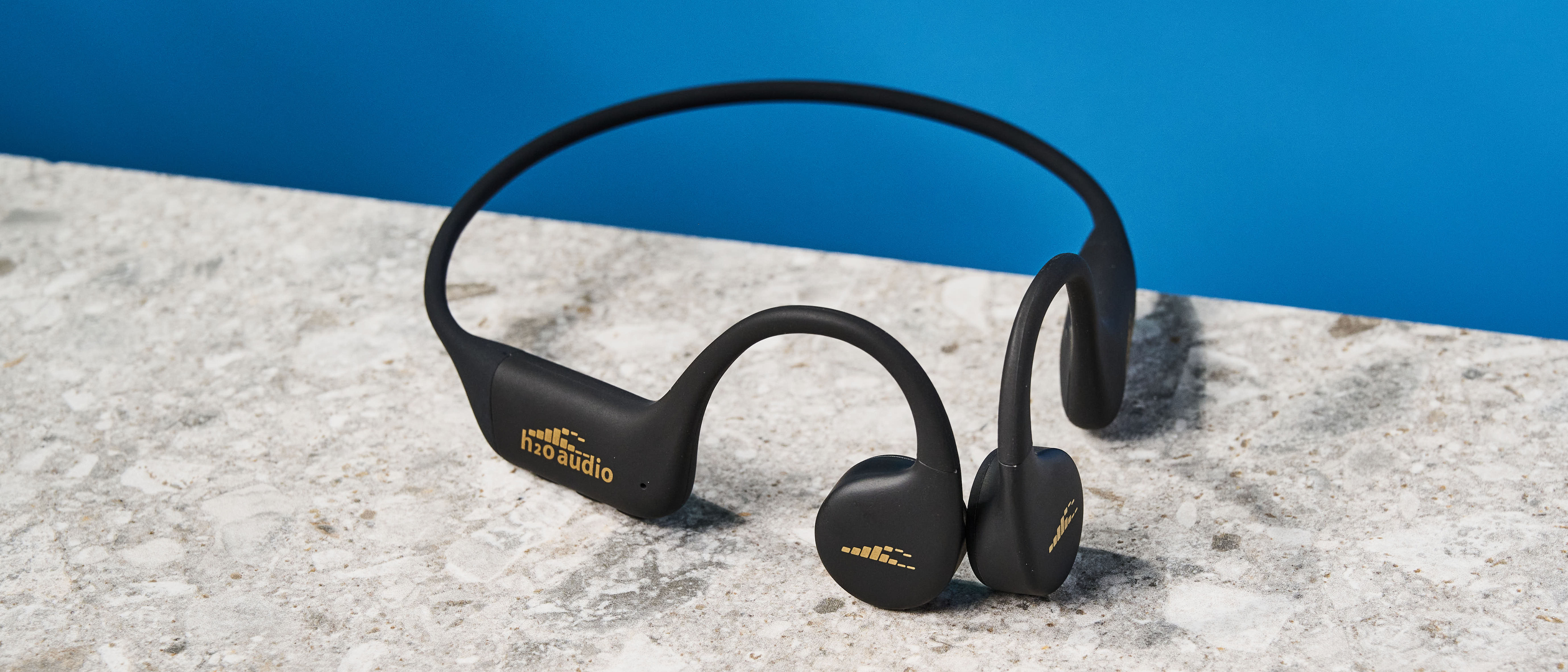Tom's Guide Verdict
The H2O Audio Tri 2 Pro bone conduction headphones are lightweight and have a comfortable and secure fit. With the Playlist+ feature, you can record and listen to music offline, and the IPX8 rating means you can dive into the depths. But the sound quality is poor and storage is limited, and the music recording feature is cumbersome.
Pros
- +
Lightweight
- +
Comfortable and secure fit
- +
Bluetooth and MP3 playback
- +
IPX8-rated for long swimming sessions
Cons
- -
Sound quality is decent only
- -
Competitors offer more storage
- -
Cumbersome music recording feature
Why you can trust Tom's Guide
Price: $199 / £187
Colors: Black
Battery life (rated): 8 hours
Paired devices max: 1
Multipoint connectivity: No
Connectivity: Bluetooth 5.3
Storage: 8GB
Weight: 1.12oz
Durability: IPX8
If you actively go to the gym or go swimming, you need the best bone conduction headphones, especially if you want to listen to music while diving into the depths. But it’s important to evaluate what you value in a pair of headphones. Do you prioritize comfort over sound quality? How deep do you want to go with them? And what’s your budget like?
The H2O Audio Tri 2 Pro are very lightweight, weighing just 1.12oz. This is a very comfortable pair of bone conduction headphones, offering a secure fit ensuring they don’t get lost while swimming. Perhaps their biggest selling point is that you can load, record and listen to music offline. Carrying an IPX8 rating, you can dive down to 3.6m for an unlimited amount of time — no more excuses to cut your workout short!
But all of this comes at a price — and not just literally. For $199, you’ll be compromising on the sound quality, storage capacity, and more.
For the complete breakdown, read my full H2O Audio Tri 2 Pro review.
H2O Audio Tri 2 Pro review: Cheat sheet
- What is it? Bone conduction headphones with built-in storage for offline playback
- Who is it for? Swimmers and gym-goers who can’t work out without music
- How much does it cost? The H2O Audio Tri 2 Pro are available for $199 / £187
- What do we like? The lightweight form factor, secure and comfortable fit, Bluetooth and MP3 playback, and the IPX8 rating for long swimming sessions
- What don’t we like? Sound quality isn’t up to the mark, competitors offer more storage, and the music recording feature is cumbersome
H2O Audio Tri 2 Pro review: Price & availability

In Autumn 2024, H2O Audio launched the Tri 2 series comprising the Tri 2 and Tri 2 Pro bone conduction waterproof headsets. The Tri 2 headphones have a retail price of $179 / £168 while the Tri 2 Pro are available for $199 / £187, and both are available to buy directly from H2O. The Tri 2 are available in either black or blue, and the Tri 2 Pro come in black.
The Tri 2 Pro are similarly priced to the Shokz OpenSwim Pro ($180) and the Shokz OpenRun Pro 2 ($179).
H2O Audio Tri 2 Pro review: Design & comfort

The H2O Audio Tri 2 Pro succeed and resemble the Tri Pro ($179). Over-ear hooks are joined together by a thin and slightly flexible but sturdy band that runs around the back of your head. A mix of plastic, titanium and silicon make up the headphones. The band was slightly big for me and didn’t sit securely around my head, but I found the headset comfortable for running, swimming and going to the gym.

The vibration drivers sit on your cheekbones just in front of your ears. Weighing approximately 1.12oz, the Tri 2 Pro are a little heavier than the Shokz OpenSwim Pro (0.96oz) but still very lightweight. The fit is also very secure as they didn’t move at all while running or even doing jumping jacks.
Swimming with the Tri 2 Pro wasn’t a problem either and they didn’t come off, but if you want added security, rest assured that the headphones are very comfortable when worn under a swimming cap too. You also get earplugs in the box.
H2O Audio Tri 2 Pro review: Controls & app

The H2O Audio Tri 2 Pro house just three controls and all of these are on the right hook. Different combinations of pressing and holding trigger various functions, such as recording for offline use (more on that soon). The buttons sit close together but are easy to reach for on land and in water, and give tactile feedback when pressed.

The H2O Audio Pro app for iOS and Android doesn’t offer a plethora of customization, but it gives you access to your offline library, firmware updates, and you can also set the duration you want to load music for. With the last feature, you can set the timer up to four hours.
H2O Audio Tri 2 Pro review: Connectivity

The H2O Audio Tri 2 Pro headphones utilize Bluetooth 5.3 to seamlessly connect to your smartphone or laptop. I had no issues pairing them with my Google Pixel 7 Pro or my MacBook Air M2. But of course, the headphones’ standout feature is Playlist+ which allows you to load and record audio from the Bluetooth connection and store it into the headphones’ memory for offline use. The built-in MP3 player can store up to 8GB of music in any format. If 2,000 songs aren’t enough for you, the Shokz OpenSwim Pro come with 32GB of storage.
I found the Playlist+ feature very easy but time consuming. Double-clicking the + symbol starts recording the media playing over Bluetooth. I found this cumbersome because you need to leave the headphones paired and playing music for hours on end. The volume will also need to be high as it will be the same on the recorded audio. The process feels inconvenient and frustrating. We said this about the first-gen headphones and I’ll say it again: Playlist+ is an ambitious feature with room for improvement.

Once that’s (finally) done, you can hit the pool without worrying about losing your music. Speaking of, the Tri 2 Pro are IPX8-rated, making them waterproof up to 3.6m / 12ft for an unlimited amount of time. The Shokz OpenSwim Pro, on the other hand, are IP68-rated and so can be submerged in water up to 2m deep for up to two hours only.
H2O Audio Tri 2 Pro review: Sound & performance
Because they’re a bone conduction headset, the H2O Audio Tri 2 Pro’s sound quality is nowhere near as good as that offered by the best wireless earbuds. They’re designed to ensure you’re aware of your surroundings while working out, and the way they sit also means that there’s a considerable amount of audio leakage.

H2O Audio says that it has used the “best sounding bone conduction acoustics design on the market that delivers immersive sound quality with amplified bass” in the Tri 2 Pro headphones. I usually listen to heavy rock tunes when working out, so I listened to a mix of Green Day, System of a Down, IDLES, and more. The sound quality, to me, wasn’t fantastic or otherworldly. On land, bass-centric tracks like SOAD’s “Holy Mountains” and IDLES’ “I’m Scum” sounded hollow. The vibrations were very noticeable even at moderate volume levels, which made listening to these tracks slightly unpleasant.
I then switched to tracks with high notes: “Get Well” and “Only a Memory” by Icon for Hire. Both songs at maximum volume sounded distorted and flat, as though there was no life in Ariel Bloomer’s vocals. The heavy drumming also pierced my ears and the vibrations were slightly uncomfortable again. I won’t lie, using the Tri 2 Pro made me miss my in-ear earbuds!
Underwater, sound quality is slightly better. IDLES’ “Television” is probably the track I listened to most while testing the Tri 2 Pro because it sounded the best, especially with my head underwater. Vocals sounded more balanced compared to other tracks, and the headphones tried their best to reproduce guitar notes — and came quite close, in my opinion. But if you want better sound and EQ presets, I’d recommend the Shokz OpenSwim Pro instead.
H2O Audio Tri 2 Pro review: Battery life

H2O Audio has improved on the first-gen’s battery life as the Tri 2 Pro offer more juice. If you’re listening over Bluetooth, the Tri 2 Pro will run for nine hours on a single charge, and this drops to six hours in memory mode. These specs are the same as the Shokz OpenSwim Pro’s. In my testing, the Tri 2 Pro died after just over eight hours while listening over Bluetooth, and after six hours while listening offline.

To ensure they’re waterproof, the Tri 2 Pro come equipped with a proprietary magnetic charger which can be connected to when the headphones are put back into the carry case. It takes just under two hours for the Tri 2 Pro to go from zero to 100%.
Should you buy the H2O Audio Tri 2 Pro?
By no means are the H2O Audio Tri 2 Pro terrible bone conduction headphones. They are extremely comfortable with a secure fit which ensures you don’t lose them while swimming. In my testing, they barely moved during strength workouts and running. Their biggest selling point is the Playlist+ feature which allows you to record and listen to music offline.

But while this sounds great in theory, the process of loading and recording music itself is too time consuming. The audio quality offered by the Tri 2 Pro isn’t stellar either, with the headphones failing to produce well-balanced sounds. You’re also limited to just 8GB of storage while competitors, like the Shokz OpenSwim Pro, offer up to 32GB.
If you don’t mind sacrificing the sound quality for a very comfortable pair of bone conduction headphones, the Tri 2 Pro could be yours. But me? I’d rather get the OpenSwim Pro and save a few dollars.

Nikita is a Staff Writer on the Reviews team at Tom's Guide. She's a lifelong gaming and photography enthusiast, always on the lookout for the latest tech. Having worked as a Sub Editor and Writer for Canon EMEA, she has interviewed photographers from all over the world and working in different genres. When she’s not working, Nikita can usually be found sinking hours into RPGs on her PS5, flying a drone (she's a licensed drone pilot), at a concert, or watching F1. Her work has appeared in several publications including Motor Sport Magazine, NME, Marriott Bonvoy, The Independent, and Metro.

